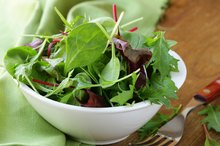What does fact checked mean?
At Healthfully, we strive to deliver objective content that is accurate and up-to-date. Our team periodically reviews articles in order to ensure content quality. The sources cited below consist of evidence from peer-reviewed journals, prominent medical organizations, academic associations, and government data.
The information contained on this site is for informational purposes only, and should not be used as a substitute for the advice of a professional health care provider. Please check with the appropriate physician regarding health questions and concerns. Although we strive to deliver accurate and up-to-date information, no guarantee to that effect is made.
Magnesium Amino Acid Chelate and Anxiety
An anxiety disorder can cause significant impairment to your ability to function and negatively impact your feelings of well-being. While psychotherapy and/or medication are often prescribed to reduce symptoms of anxiety, some research has shown that magnesium supplementation with chelated magnesium can also help. Consult your doctor before using any dietary supplements.
Magnesium Amino Acid Chelate
Magnesium is an important mineral that plays a role in more than 300 metabolic reactions. Your body needs magnesium for energy production, enzyme activation, calcium regulation and to make healthy bones and teeth. Many forms of magnesium are available in supplement form. Magnesium amino acid chelate, such as magnesium asparate, glycinate or taurinate, are magnesium supplements in which magnesium is bound to, or chelated with, amino acids 2. Chelated magnesium supplements are believed to more absorbable forms of magnesium.
- Magnesium is an important mineral that plays a role in more than 300 metabolic reactions.
- Chelated magnesium supplements are believed to more absorbable forms of magnesium.
Anxiety and Magnesium Deficiency
Magnesium as Treatment for Bipolar Disorder
Learn More
Anxiety disorders affect millions of people every year. As of 2011, the exact causes of anxiety disorders are not completely understood. A true magnesium deficiency is not common. Low levels of magnesium can contribute to symptoms of anxiety, irritability and insomnia, according to clinical nutritionist Krispin Sullivan 1. Some studies have shown that magnesium supplementation may help reduce some of these symptoms.
- Anxiety disorders affect millions of people every year.
- As of 2011, the exact causes of anxiety disorders are not completely understood.
Clinical Evidence
A study published in the July 7, 2004 issue of the "Journal of Women's Health & Gender-Based Medicine" found that women with premenstrual-related symptoms of anxiety experienced a significant decrease in their symptoms through supplementation of magnesium plus vitamin B-6 3. Another study, published in 2006 in the journal, "Medical Hypotheses," examined the effects of magnesium glycinate or magnesium taurinate supplementation on patients suffering from major depression 4. The researchers present case histories of patients suffering from a variety of concurrent mental health symptoms, including anxiety, insomnia and irritability, whose symptoms improved after being treated with the magnesium supplement.
Considerations
How Much Magnesium Per Day?
Learn More
While magnesium amino acid chelates may help symptoms of anxiety, you should not use nutritional supplements to self-treat your symptoms 2. Do not attempt to self-diagnose nutritional deficiencies or anxiety disorders. Consult your doctor if you think you have an anxiety disorder. If you choose to use a chelated form of magnesium, inform your doctor, especially if you have a medical condition. Magnesium supplements can interact with certain medications and may cause unwanted side effects.
- While magnesium amino acid chelates may help symptoms of anxiety, you should not use nutritional supplements to self-treat your symptoms 2.
- If you choose to use a chelated form of magnesium, inform your doctor, especially if you have a medical condition.
Related Articles
References
- Krispin.com: Magnesium Update
- Drugs.com: Magnesium Amino Acid Chelate
- Journal of Women's Health & Gender-Based Medicine; A Synergistic Effect of a Daily Supplement for 1 Month of 200 mg Magnesium plus 50 mg Vitamin B6 for the Relief of Anxiety-Related Premenstrual Symptoms: A Randomized, Double-Blind, Crossover Study; M. De Souza et al.; July 7, 2004
- Medical Hypotheses; Rapid Recovery from Major Depression Using Magnesium Treatment; G. Eby and K. Eby; 2006
- Rodríguez-Morán M, Guerrero-Romero F. Oral Magnesium Supplementation Improves Insulin Sensitivity and Metabolic Control in Type 2 Diabetic Subjects: A randomized double-blind controlled trial. Diabetes Care.2003 Apr;26(4):1147-52. doi:10.2337/diacare.26.4.1147
- Office of Dietary Supplements/National Institutes of Health. Magnesium: Fact Sheet for Health Professionals. Bethesda, Maryland; updated July 11, 2019.
- Kass LS, Poeira F. The effect of acute vs chronic magnesium supplementation on exercise and recovery on resistance exercise, blood pressure and total peripheral resistance on normotensive adults. J Int Soc Sports Nut. 2015;12:19. doi:10.1186/s12970-015-0081-z
- Morais JBS, Severo JS, de Alencar GRR, et al. Effect of magnesium supplementation on insulin resistance in humans: A systematic review. Nutrition. 2017 Jun;38:54-60. doi:10.1016/j.nut.2017.01.009
- Rosanoff A, Weaver CM, Rude RK. Suboptimal magnesium status in the United States: are the health consequences underestimated? Nutr Rev. 2012 Mar;70(3):153-64. doi:10.1111/j.1753-4887.2011.00465.x
- Zhang X, Li Y, Del Gobbo LC, et al. Effects of Magnesium Supplementation on Blood Pressure: A Meta-Analysis of Randomized Double-Blind Placebo-Controlled Trials. Hypertension. 2016;68:324-33. doi:10.1161/HYPERTENSIONAHA.116.07664
Writer Bio
Ashley Miller is a licensed social worker, psychotherapist, certified Reiki practitioner, yoga enthusiast and aromatherapist. She has also worked as an employee assistance program counselor and a substance-abuse professional. Miller holds a Master of Social Work and has extensive training in mental health diagnosis, as well as child and adolescent psychotherapy. She also has a bachelor's degree in music.









